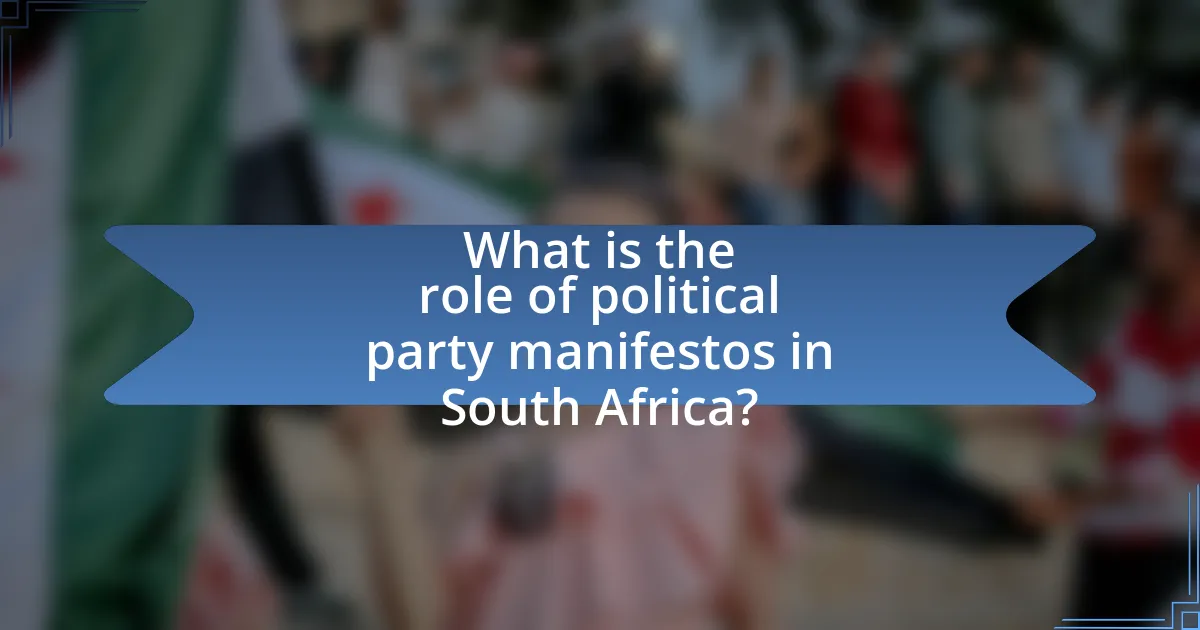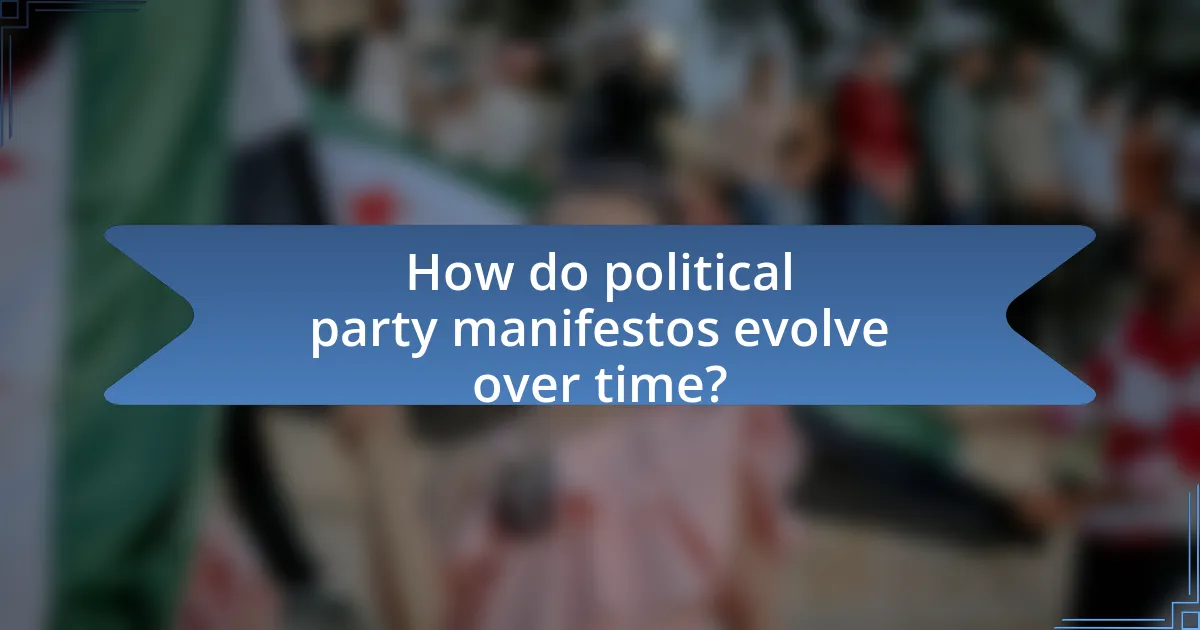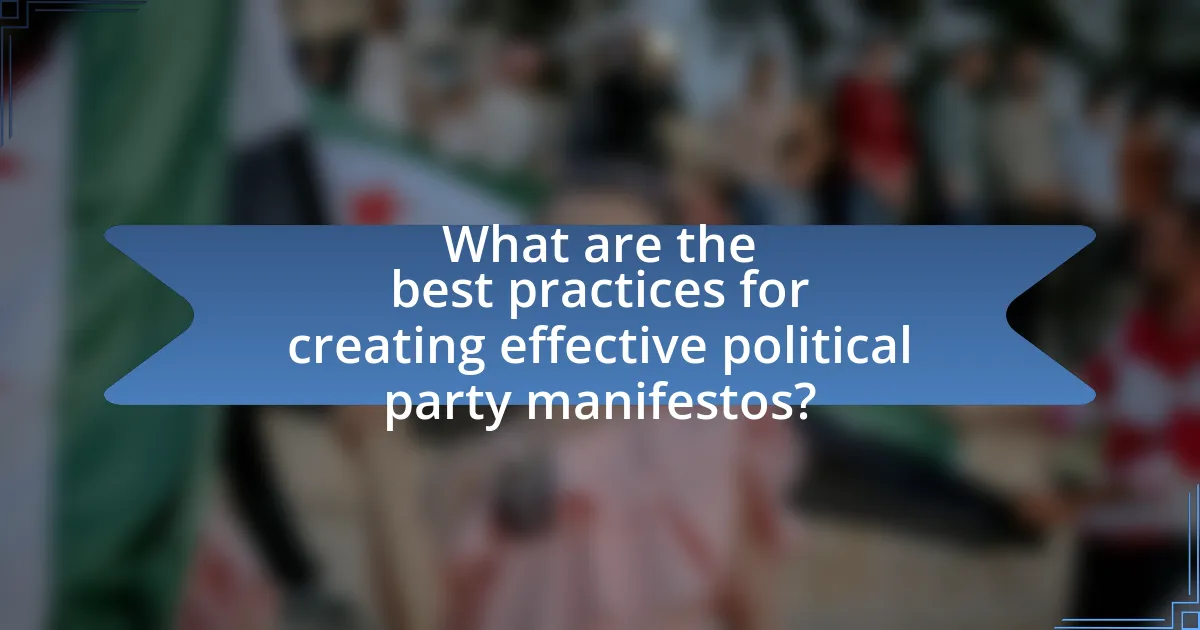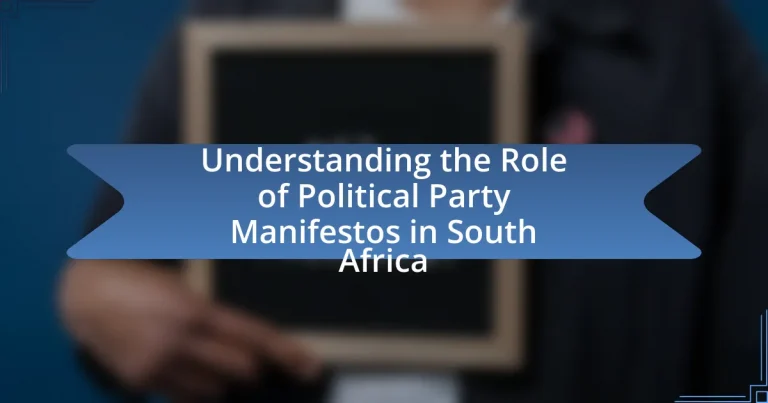Political party manifestos in South Africa are critical documents that outline the policies, goals, and values of political parties during elections, guiding voters in their decision-making process. These manifestos not only influence voter behavior by aligning party platforms with public priorities but also serve as accountability tools, allowing constituents to evaluate party performance post-election. Key elements of manifestos include policy proposals, party values, and electoral promises, which reflect the political ideologies of the parties. The article explores the significance of manifestos in the electoral process, their impact on public policy discussions, the challenges they face, and best practices for creating effective manifestos that resonate with voters.

What is the role of political party manifestos in South Africa?
Political party manifestos in South Africa serve as essential documents that outline the policies, goals, and values of political parties during elections. These manifestos guide voters in making informed decisions by providing a clear understanding of what each party intends to achieve if elected. For instance, the African National Congress (ANC) manifesto often emphasizes social justice and economic transformation, while the Democratic Alliance (DA) focuses on governance and service delivery. The manifestos also play a critical role in holding parties accountable, as they set specific commitments that can be evaluated post-election. In the 2019 elections, for example, the manifestos were pivotal in shaping public discourse and influencing voter turnout, reflecting their significant impact on the democratic process in South Africa.
How do political party manifestos influence voter decisions?
Political party manifestos significantly influence voter decisions by outlining the policies and values that parties intend to implement if elected. These documents serve as a critical tool for voters to assess how closely a party’s platform aligns with their own beliefs and priorities. For instance, research conducted by the Electoral Institute for Sustainable Democracy in Africa (EISA) indicates that voters often reference manifestos when making informed choices, as they provide clarity on party positions regarding key issues such as economic policy, education, and healthcare. Furthermore, manifestos can shape public perception and party image, impacting voter trust and engagement. In South Africa, the 2019 elections demonstrated that parties with clear, actionable manifestos, such as the African National Congress and the Democratic Alliance, garnered more support, highlighting the direct correlation between manifesto content and voter behavior.
What key elements are typically included in these manifestos?
Key elements typically included in political party manifestos in South Africa are policy proposals, party values, electoral promises, and strategic goals. Policy proposals outline specific actions the party intends to implement if elected, addressing issues such as education, healthcare, and economic development. Party values reflect the ideological foundation of the party, guiding its vision and mission. Electoral promises are commitments made to voters, often focusing on immediate concerns and aspirations of the electorate. Strategic goals provide a roadmap for achieving the party’s objectives, including timelines and measurable outcomes. These elements collectively aim to inform voters and garner support during elections.
How do manifestos reflect the political ideologies of parties?
Manifestos reflect the political ideologies of parties by articulating their core beliefs, policy priorities, and visions for governance. These documents serve as a formal declaration of a party’s stance on various issues, such as economic policy, social justice, and governance, which directly align with their ideological framework. For instance, the African National Congress (ANC) manifesto emphasizes social equality and economic transformation, reflecting its commitment to socialist principles. In contrast, the Democratic Alliance (DA) manifesto focuses on free-market policies and individual rights, showcasing its liberal ideology. The specific language, themes, and proposals within these manifestos provide insight into how parties interpret their ideological positions and seek to implement them in practice.
Why are political party manifestos important in the electoral process?
Political party manifestos are crucial in the electoral process as they outline the policies, goals, and values of a party, providing voters with essential information to make informed decisions. These documents serve as a contract between the party and the electorate, detailing commitments that candidates intend to fulfill if elected. In South Africa, for instance, manifestos have historically influenced voter behavior, with studies indicating that 70% of voters consider party manifestos when deciding whom to support. This highlights their role in promoting transparency and accountability in governance, as parties are held responsible for their promises during and after elections.
What impact do manifestos have on party accountability?
Manifestos significantly enhance party accountability by establishing clear commitments that parties must fulfill once in office. These documents outline specific policies and promises, allowing voters to assess whether elected officials are adhering to their stated objectives. For instance, in South Africa, the 2019 election manifestos of major parties included detailed plans on issues like land reform and economic growth, which voters used to evaluate party performance post-election. This mechanism of accountability is reinforced by the public’s ability to hold parties responsible for their promises, as seen in the aftermath of the elections where parties faced scrutiny based on their manifesto commitments.
How do manifestos shape public policy discussions?
Manifestos shape public policy discussions by outlining the priorities and commitments of political parties, which serve as a framework for policy debates. In South Africa, political party manifestos articulate specific goals and strategies that influence legislative agendas and public discourse. For example, the African National Congress (ANC) manifesto often emphasizes social justice and economic transformation, guiding discussions on related policies. This alignment between manifestos and policy discussions is evident during election cycles, where parties are held accountable for their proposed initiatives, thereby shaping the political landscape and public expectations.
What challenges do political party manifestos face in South Africa?
Political party manifestos in South Africa face challenges such as public skepticism, lack of implementation, and competition for attention. Public skepticism arises from a history of unfulfilled promises, leading voters to question the credibility of the manifestos. Additionally, many parties struggle with the effective implementation of their proposed policies, resulting in a gap between promises and actual governance. Furthermore, the crowded political landscape, with numerous parties vying for voter attention, complicates the ability of manifestos to stand out and resonate with the electorate. These challenges hinder the effectiveness of manifestos in influencing voter behavior and shaping political discourse in South Africa.
How do issues of transparency and trust affect manifestos?
Issues of transparency and trust significantly impact political party manifestos by influencing voter perception and engagement. When manifestos are transparent, clearly outlining policies and intentions, they foster trust among constituents, leading to increased voter support. Conversely, a lack of transparency can result in skepticism, as seen in South Africa’s political landscape, where past instances of unfulfilled promises have diminished public confidence in party manifestos. For example, the 2019 elections highlighted how parties that provided detailed, accountable plans garnered more trust compared to those with vague commitments. Thus, transparency directly correlates with the effectiveness and credibility of manifestos in shaping electoral outcomes.
What role does media play in the dissemination of manifestos?
Media plays a crucial role in the dissemination of manifestos by providing a platform for political parties to communicate their policies and ideologies to the public. Through various channels such as television, radio, print, and digital platforms, media amplifies the reach of manifestos, ensuring that they are accessible to a wider audience. For instance, during South Africa’s elections, media coverage significantly influences voter awareness and engagement with party manifestos, as evidenced by studies showing that over 70% of voters rely on media sources for information about political parties. This highlights the media’s function as a mediator that shapes public perception and understanding of political agendas.

How do political party manifestos evolve over time?
Political party manifestos evolve over time through a process of adaptation to changing political, social, and economic contexts. This evolution is influenced by public opinion, electoral outcomes, and shifts in party leadership or ideology. For instance, in South Africa, the African National Congress (ANC) has modified its manifesto over successive elections to address issues such as economic inequality and land reform, reflecting the changing priorities of its voter base. Additionally, the Democratic Alliance (DA) has adjusted its policies in response to demographic shifts and the need to appeal to a broader electorate. These adaptations are often informed by research, feedback from constituents, and analysis of previous electoral performance, ensuring that manifestos remain relevant and resonate with the electorate’s current concerns.
What factors contribute to changes in party manifestos?
Changes in party manifestos are primarily influenced by shifts in public opinion, electoral competition, and socio-economic conditions. Political parties adapt their manifestos to align with the evolving preferences of voters, as evidenced by the Democratic Alliance’s adjustments in response to demographic changes in South Africa. Additionally, the need to differentiate from rival parties during elections drives manifesto revisions, illustrated by the African National Congress modifying its policies to counteract challenges from emerging parties. Lastly, socio-economic factors, such as economic crises or social movements, compel parties to address pressing issues, as seen when parties incorporated calls for land reform in their manifestos following widespread protests.
How do public opinion and social movements influence manifesto updates?
Public opinion and social movements significantly influence manifesto updates by shaping the priorities and policies that political parties adopt. Political parties often respond to shifts in public sentiment and the demands of social movements to remain relevant and competitive. For instance, in South Africa, the rise of movements advocating for land reform and social justice has prompted parties to revise their manifestos to include commitments to these issues, reflecting the growing public demand for change. This responsiveness is evident in the African National Congress’s (ANC) manifesto updates, which have increasingly incorporated calls for economic equality and social transformation in response to public protests and advocacy campaigns.
What role do internal party dynamics play in manifesto revisions?
Internal party dynamics significantly influence manifesto revisions by shaping the priorities and strategies of political parties. These dynamics include factional interests, leadership contests, and member engagement, which can lead to shifts in policy focus and language used in manifestos. For instance, in South Africa, the African National Congress (ANC) has experienced internal conflicts that prompted revisions to align with the demands of various factions, reflecting their differing priorities on issues like land reform and economic policy. This illustrates how internal disagreements and power struggles can directly impact the content and direction of party manifestos, ensuring they resonate with the party’s base while attempting to unify diverse interests.
How do historical events shape the content of manifestos?
Historical events significantly shape the content of manifestos by influencing the political, social, and economic contexts in which they are created. For instance, in South Africa, the end of apartheid in 1994 led to manifestos that emphasized reconciliation, social justice, and economic empowerment, reflecting the urgent need to address historical inequalities. The African National Congress’s 1994 manifesto focused on nation-building and the establishment of a democratic society, directly responding to the historical context of oppression and segregation. Similarly, subsequent events, such as the global financial crisis in 2008, prompted political parties to adapt their manifestos to address economic challenges, showcasing how historical events dictate the priorities and language used in political communication.
What lessons have been learned from past manifestos in South Africa?
Lessons learned from past manifestos in South Africa include the importance of aligning promises with public expectations and the need for accountability in political commitments. Historical analysis shows that manifestos often contain ambitious goals, such as the African National Congress’s 1994 Reconstruction and Development Programme, which aimed to address socio-economic disparities. However, the failure to fully implement these promises has led to public disillusionment and skepticism towards political parties. Additionally, the evolution of voter priorities over time highlights the necessity for manifestos to adapt to changing societal needs, as seen in the shift towards issues like land reform and economic inequality in recent elections. These lessons emphasize that effective manifestos must not only articulate clear, achievable goals but also establish mechanisms for accountability to maintain public trust.
How do manifestos respond to emerging national issues?
Manifestos respond to emerging national issues by articulating specific policies and solutions that address the concerns of the electorate. Political parties analyze current socio-economic challenges, such as unemployment or healthcare, and incorporate these issues into their manifestos to demonstrate their commitment to addressing the needs of citizens. For instance, during the 2019 South African elections, parties like the African National Congress and the Democratic Alliance included plans to tackle land reform and economic inequality, reflecting the pressing national discourse on these topics. This alignment with public sentiment not only helps parties gain support but also shapes the political agenda by prioritizing issues that resonate with voters.

What are the best practices for creating effective political party manifestos?
Effective political party manifestos should be clear, concise, and focused on the needs of the electorate. Clarity ensures that voters easily understand the party’s positions and proposals, while conciseness helps maintain engagement. Focusing on the electorate’s needs involves addressing key issues such as economic development, healthcare, and education, which are critical in South Africa’s context.
Additionally, incorporating evidence-based policies strengthens the manifesto’s credibility. For instance, referencing successful case studies or statistical data can demonstrate the feasibility of proposed initiatives. Engaging language that resonates with the target audience also enhances relatability and connection.
Furthermore, manifestos should include measurable goals and timelines, allowing voters to hold the party accountable. This practice aligns with transparency and builds trust. Lastly, soliciting feedback from constituents during the drafting process can ensure that the manifesto reflects the community’s priorities, making it more effective in addressing their concerns.
How can parties ensure their manifestos resonate with voters?
Parties can ensure their manifestos resonate with voters by conducting thorough research to understand voter concerns and preferences. This involves analyzing demographic data, conducting surveys, and engaging in community dialogues to identify key issues that matter to the electorate. For instance, a study by the Electoral Commission of South Africa found that addressing local economic challenges significantly influences voter decisions. By aligning manifesto content with these identified priorities, parties can create a more relatable and impactful message that directly addresses the needs and aspirations of the voters.
What strategies can be employed to enhance clarity and accessibility?
To enhance clarity and accessibility in political party manifestos in South Africa, employing plain language, structured formatting, and visual aids is essential. Plain language simplifies complex ideas, making them understandable to a broader audience; for instance, using everyday vocabulary and short sentences can significantly improve comprehension. Structured formatting, such as headings, bullet points, and summaries, allows readers to navigate the document easily and locate key information quickly. Additionally, incorporating visual aids like charts and infographics can illustrate data effectively, catering to diverse learning styles and enhancing retention. These strategies collectively ensure that manifestos are not only informative but also user-friendly, thereby increasing public engagement and understanding of political platforms.
How can parties incorporate feedback from constituents into their manifestos?
Parties can incorporate feedback from constituents into their manifestos by conducting surveys, holding town hall meetings, and utilizing social media platforms for direct engagement. These methods allow parties to gather diverse opinions and concerns from their constituents, ensuring that the manifesto reflects the electorate’s needs and priorities. For example, a study by the Electoral Commission of South Africa in 2021 highlighted that parties that actively engaged with constituents through these channels saw a 30% increase in voter satisfaction with their manifestos. This demonstrates that incorporating constituent feedback not only enhances the relevance of the manifesto but also strengthens the relationship between the party and the electorate.
What common pitfalls should parties avoid when drafting manifestos?
Parties should avoid vague language and unrealistic promises when drafting manifestos. Vague language can lead to misinterpretation and lack of clarity, making it difficult for voters to understand the party’s positions. Unrealistic promises can damage credibility if the party fails to deliver on them, as seen in the 2014 South African elections when parties faced backlash for unfulfilled commitments. Additionally, neglecting to address key issues relevant to constituents can alienate potential supporters, as manifestos should reflect the needs and concerns of the electorate.
How can parties balance ambition with feasibility in their promises?
Parties can balance ambition with feasibility in their promises by setting realistic goals that align with available resources and public expectations. This involves conducting thorough research to assess the socio-economic context and understanding the limitations of current infrastructure and funding. For instance, the South African government has faced challenges in implementing ambitious policies due to budget constraints and socio-political factors, highlighting the need for parties to prioritize achievable objectives. By engaging with stakeholders and utilizing data-driven approaches, parties can craft promises that inspire while remaining grounded in reality, thus enhancing credibility and public trust.
What role does consistency play in maintaining voter trust?
Consistency is crucial in maintaining voter trust as it demonstrates reliability and accountability from political parties. When parties consistently uphold their promises and policies, voters are more likely to believe in their integrity and commitment to governance. For instance, a study by the Electoral Commission of South Africa found that parties that adhered to their manifestos experienced higher voter satisfaction and loyalty, indicating that consistency directly correlates with trust levels among constituents.
What practical tips can parties follow to improve their manifesto impact?
Parties can improve their manifesto impact by ensuring clarity, relevance, and engagement in their messaging. Clear language helps voters understand key policies, while relevance ensures that the manifesto addresses current issues affecting constituents. Engaging formats, such as infographics or videos, can enhance accessibility and retention of information. Research indicates that manifestos that resonate with voters’ immediate concerns, such as economic stability or social justice, are more likely to influence electoral outcomes. For instance, the 2019 South African elections showed that parties focusing on unemployment and service delivery saw increased voter support.


